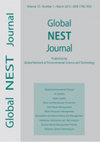新鲜生物质与添加剂共热解制富氢气。
IF 1.2
4区 环境科学与生态学
Q4 ENVIRONMENTAL SCIENCES
引用次数: 3
摘要
含水量为70wt的新鲜无花果叶片的热解特性。%在TGA设置中进行了研究。在固定床反应器系统中研究了不同操作参数对生物质热解的影响。在382~490℃的温度范围内,CaO的加入使样品的重量进一步下降,但减少了12wt。新鲜生物质热解为一级反应,活化能约为29.8 kJ mol,添加CaO使活化能降至20.4 kJ mol。通过对温度范围的研究,发现较高的温度有利于新鲜生物质热解产氢。CaO的碳化和水化作用增强了水气转换反应,使产氢率提高。最高的氢含量(约70vol。当CaO/生物质质量比增加到0.3时,氢气浓度和产氢量达到23.2 ml g-生物质。未经预干燥的新鲜生物质热解显示出制氢的潜力。本文章由计算机程序翻译,如有差异,请以英文原文为准。
Producing hydrogen-rich gas by fresh biomass co-pyrolysis with additive.
Pyrolysis properties of fresh ficus lacor leaves with moisture content of 70wt. % was investigated in a TGA setup. The effects of different operating parameters on pyrolysis of biomass were studied in a fixed-bed reactor system. With addition of CaO, there showed an additional decrease in weight at temperature range of 382~490 C, but 12wt. % weight was recovered in the first stage (40~220 C). Fresh biomass pyrolysis was calculated to be first order reaction with activation energy about 29.8 kJ mol. Activation energy was lowered to 20.4 kJ mol by addition of CaO. With scope of temperature studied, higher temperature was found always favor hydrogen production during pyrolysis of fresh biomass. Carbonation and hydration of CaO enhanced water gas shift reaction (WGS) which led to hydrogen yield increasing. The highest hydrogen content (around 70vol. %) of hydrogen concentration and hydrogen yield (23.2 ml g-biomass) were achieved when CaO/biomass mass ratio increased to 0.3. Pyrolysis of fresh biomass without pre-drying showed the potential of hydrogen production.
求助全文
通过发布文献求助,成功后即可免费获取论文全文。
去求助
来源期刊

Global Nest Journal
环境科学-环境科学
CiteScore
1.50
自引率
9.10%
发文量
100
审稿时长
>12 weeks
期刊介绍:
Global Network of Environmental Science and Technology Journal (Global NEST Journal) is a scientific source of information for professionals in a wide range of environmental disciplines. The Journal is published both in print and online.
Global NEST Journal constitutes an international effort of scientists, technologists, engineers and other interested groups involved in all scientific and technological aspects of the environment, as well, as in application techniques aiming at the development of sustainable solutions. Its main target is to support and assist the dissemination of information regarding the most contemporary methods for improving quality of life through the development and application of technologies and policies friendly to the environment
 求助内容:
求助内容: 应助结果提醒方式:
应助结果提醒方式:


